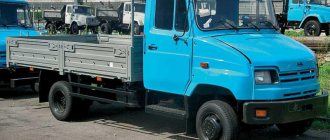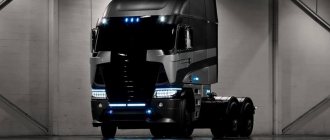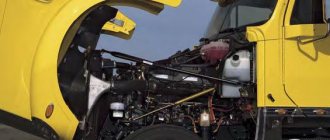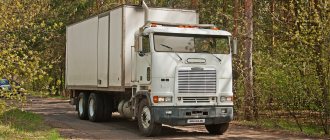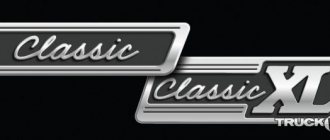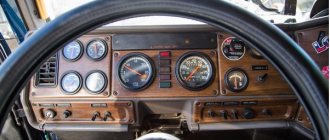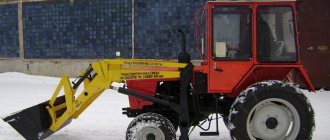Freightliner is a company with extensive experience in the production of heavy transport. In the 30s of the 20th century, leading US designers came together to create trucks that could most effectively cope with difficult road conditions. And already in 1942, the Freightliner company was created, producing trucks that fully correspond to the stated goals. The Columbia model is a bright representative of modern tractors of this line, which have gained great popularity all over the world. This success was achieved thanks to the EGR system, which regulates the circulation of exhaust gases, efficiency and an aerodynamic shape, which allows the vehicle to increase its payload.
Features of the Columbia model
Production of this model began in 2000. To achieve great success among truckers, a modern truck must combine stylish design and high technical potential. The appearance of this truck immediately attracts attention. When manufacturing the cabin, the manufacturer placed the main emphasis on ergonomic characteristics and build quality.
The driver's seat is designed in such a way that the driving process does not cause any difficulties. The instrument panel is low for good visibility. The driver can easily control the temperature in the cabin thanks to the convenient placement of instruments that control the heating and air conditioning system.
When manufacturing the cabin, the manufacturer placed the main emphasis on ergonomic characteristics and build quality
It should be noted that the design of the Columbia model was developed in such a way as to improve the driving characteristics of the tractor. The aerodynamic parameters were carefully worked out. The design of the radiator grille and headlights gives the car elegance. But the main goal of the streamlined design is not a stylish appearance, but a reduction in fuel consumption. The fuel consumption of the tractor without a load is 30 liters per 100 kilometers, which is very low for cars of this class.
Efficiency is very attractive
Freightliner Columbia's legendary technology delivers the ultimate reliability, durability and efficiency of a traditional truck in the 21st century. Freightliner Columbia's aerodynamic design reduces drag and delivers superior fuel economy, and when combined with the truck's reduced curb weight, you'll be able to haul more payload.
The Freightliner Columbia is available with a BBC of 112 or 120 inches (front of bumper to back of cab), and with 7 SleeperCab and non-SleeperCab options (“Day Cab”). You can choose that Freightliner Columbia
that suits your business needs.
The picture shows a Freightliner Columbia truck tractor with a cab without a sleeper and BBC = 112 inches, and the largest option is a cab with a 70-inch sleeper compartment and BBC = 120 inches:
With great fuel economy, low maintenance and lower operating costs, the Freightliner Columbia makes efficiency very attractive.
Corner office
The comfortable and ergonomically designed cab makes the Freightliner Columbia much easier to operate. The curved front panel is set low for increased visibility; The indicators are backlit, making information easy to read day and night. The 21-setting air conditioning and heating system is within easy reach and provides optimal climate control for the driver.
Efficient and reliable.
Comfort at a modern level
Freightliner cabs provide maximum space and comfort. These cabs have plenty of storage space for personal items and other comfort features that give the driver a more homey feel while on the road.
Cabin structure
American designers produce 7 types of cabins for this model. The distance from the hood to the rear of the cabin can be within 2.8–3 meters. The Day Cab is the most basic. It is not equipped with a sleeping place, as it is not intended for long trips.
Other types of cabins differ in the size of the sleeping compartment. The Raised Roof cabin is the largest. It is equipped with a high roof and a berth 178 centimeters wide. The front of the cabin is quite spacious. Personal items can be stored under the sleeping area and in numerous drawers designed for this purpose.
The truck's dashboard features Freightliner's signature style. There are a lot of sensors on it. The backlighting of all indicators is a distinctive feature of trucks of this American brand. The panel is equipped with natural wood finishing. Its curved shape helps the driver easily reach any control.
The curved shape of the instrument panel helps the driver easily reach any control
The cabin is made of solid aluminum, which ensures its low weight. You should also pay attention to the large distance between the seats and the flat floor, which ensures comfortable movement around the cabin. The driver's seat is equipped with air suspension, position indicators and footrests. The chair is quite wide with a high back. The steering wheel is adjustable in height and tilt. One of the competitive advantages of the cab of this truck is good sound insulation.
Columbia
When creating the next hood tractor, Freightliner designers sought to create a truck in the best traditions of North America. The new Columbia truck series is, so to speak, a twin of its predecessor, the Century Class, which you had the opportunity to meet on the pages of this site. When creating new trucks, Americans have such a concept as tradition, and this concept is associated primarily with a powerful and even slightly bulky hooded tractor, which, according to the same traditions, shines with a plumage of numerous chrome, and this style, by the way, can be seen in all Freightliner models.
As I already said, the Columbia tractor has a clear relationship with the Century Class truck, but in many ways this model is significantly different from its brother, and this is noticeable primarily in the design of the truck, and indeed in the configuration. As for the design of the tractor, here the developers decided to use all the experience accumulated over the past seventy years of truck production, and when creating it, special attention was paid to design reliability, long service life and ease of maintenance. The new Columbia truck is notable for the fact that it was manufactured with economical equipment for this class of tractors, but even though it is made almost in a budget version, it is generally difficult to compete with it in terms of a high level of comfort.
First of all, we should pay attention to the fact that it is not so easy to achieve streamlining in classic models with a hood layout without spoiling the appearance. From not so distant ancestors who traveled around the states of North America some decades ago, only the general principles of layout and huge, in several modifications, sizes of a sleeping bag remained in the truck. Unlike the Century Class series, it already has a more clearly defined aerodynamic shape, and in general the cabin differs only in design and more active use of aluminum - the power steel frame is the same here.
As usual with bonnets, the cabin is rigidly attached to the frame at the front, but the sleeping bag has a double suspension, which has both two air bags and two shock absorbers. The front tail and the hood itself became more sloping forward, it began to have excellent aerodynamic characteristics. The best proof of this is compliance with the European strength standard ECR R-29 and the results of the Swedish crash test. The wings of the truck actually have the shape of a real sea wave.
A huge spoiler hump, if there is one, smoothes and redirects air flow while adding further percentages of efficiency. And to improve such data, a set of side vertical fairings is added to the spoiler on the rear wall of the cabin, which in turn divert incoming flows from the cargo attached to the rear, preventing the formation of too large a turbulent zone in front of its front wall. The Columbia truck also has what's called an aerodynamic skirt on the side of the frame, which runs the entire length of the truck, while hiding the huge fuel tanks on both sides.
And this solution looks even better, and in some ways more attractive, than the overlays like in previous series. The designers also changed the front bumper; it is made even more streamlined than in previous series, and is also painted to match the color of the cabin, and the familiar chrome, like on the old Americans, remains here, albeit a little of it. The main element of the truck’s chrome plating is, of course, the radiator grille; it has also become more rounded, like the entire hood, but nevertheless it has the familiar rectangle that we are familiar with.
The truck's headlights have also changed; unlike their Century counterpart, they do not have a classic look, but a teardrop-shaped, modern shape, which in turn have chrome linings. And the chrome set in the tail of the truck continues with rear-view mirrors, manufactured by the company “Mekra”, which can be installed either two or four, depending on the wishes of the client. The truck also has the usual traditional running boards, which in turn also sparkle with chrome, and their continuation is a metal box, the lid of which is perforated, and complete with a small step, it forms steps leading to the rear of the cab, where the connectors for the semi-trailer are located.
The middle of the box itself houses four batteries that power the truck's complete electronics. Well, the set of chrome is completed by two front metal mudguards with holders on the rear tandem. The rear ones are made flexible on a regular pipe, painted in the color of the frame. All this is good, but there’s only one thing that the truck lacks: the usual two, or at least one, huge exhaust pipe located behind the cab. And the interior of the cabin is also amazing, the seats have all types of adjustments and are equipped with armrests for convenience, and the driver’s seat is generally on air suspension.
This truck, much like modern passenger cars, has a full electrical package, such as power windows, central locking, adjustable exterior mirrors, which are also electrically heated, and this despite the fact that the Columbia is by no means a luxury option. The developers of the truck also took care of the temperature inside the cabin; it has air conditioning, a standard stove, and an autonomous heater. The Columbia truck has eight cab versions, and in the version with a spoiler, the height of the cabin is simply amazing, since the spoiler hump is a natural roof. Nothing interferes with movement around the cabin - between the seats, of which there are two, there is free space, neither the gearbox slides nor the handbrake lever, which are traditionally located there.
The steering column is adjustable not only in angle, but also in height, all depending on the size of the driver. The column does not have numerous steering column levers, so beloved by European manufacturers - only a turn signal and a gearshift control “paddle”. Even on the dashboard there weren't as many switches as one might expect. Control of the heater and airflow - and only a dozen buttons: engine impeller, wipers/washers, two for head optics, one for cabin lights, engine brake, cruise control, heated mirrors and air conditioning. A little further away there are two large toggle switches - for locking and unlocking the center differential and for adjusting the pressure in the rear air suspension.
They have two positions: automatic mode and mode with reduced rear suspension clearance. The curved front panel is set low for increased visibility; The indicators were backlit, easy to read day or night, and the number of bells and whistles did not indicate that we were in a truck of the electronic age. It looked more like something from the 60s or 70s! It is dominated by two completely simple analog instruments - the speedometer and tachometer. On either side of them are small and equally simple analog instruments showing the temperature of the engine coolant (though in degrees Fahrenheit), oil pressure, amount of fuel in the tank, air pressure in both brake circuits.
Above all this analogue kingdom there is a modest display (if the Americans did not consider it necessary to install a computer display, then it is certainly not needed on Ukrainian roads), which displays the mileage indicator and the state of charge of the batteries. On the right side of the dashboard there is an indicator showing the engaged gear, an indicator of air pressure in the rear suspension circuit and an unusual indicator (as if from a vacuum cleaner) - it shows the degree of contamination of the air filter. The hand brake is as usual - a trailer brake lever and two buttons that control the pneumatics, separately for the tractor and for the trailer.
It only remains to add that the cabin also has an audio system, a set for a smoker, several niches for small items and just a couple of wide cup holders (or even “bottle holders”). Above the windshield there are several mezzanine niches of different sizes. Nets prevent objects from falling out of them. In a more expensive configuration, these niches would be made with plastic covers; the plastic itself would be more pleasant to the touch. The more expensive version would have numerous cup holders throughout the cabin.
As I already wrote, the Columbia truck has eight cab versions, one option is a cab without a sleeping bag, the so-called day version (“Day Cab”), and the other seven (“SleeperCab”) have different dimensions of the rear compartment. Here, for example, are the options for cabins with a sleeping bag: 34 Mid-Roof - a cabin with an 860 mm (34 inches) sleeping compartment and a medium roof, 48 Mid-Roof - with a 1200 mm (48 inches) sleeping compartment and the same roof, there is also 1470 and 1780 mm., there are also options with a high roof Raised Roof, the modification of which is also due to the size of the sleeping bag in inches.
The beds in the sleeping compartment are equipped not just with seat belts for sleeping, but with peculiar side nets that hold the sleeper in case of emergency braking. As I already wrote, the developers of the truck sought to make it easier to maintain the vehicle, and therefore access to the engine became very easy, since the hood lid comes off at 90o. The engine on the Columbia truck is a traditional one for North American tractors - it is an inline six, in this case manufactured by Caterpillar, which develops a power of 450 horsepower.
But this figure is an American power indicator, which, according to the local standard, is taken from the rear axle. By European standards (power readings are taken from the flywheel), it will exceed well over half a thousand and amount to approximately 550 “horses”. With such a herd, the tractor can transport not only a standard semi-trailer with a total weight of just over 30 tons, but also a tank truck with a load of at least 150 tons. To transform all this power to the wheels, you need an appropriate transmission, which was an automatic transmission from Eaton-Fuller. There is a clutch pedal on the tractor, but you only need to use it when starting from a standstill.
This box has both fully automatic and manual modes. Moreover, all its controls are now placed on the steering column lever. A small toggle switch at the end of the lever changes the gearbox operating mode and has only four positions: “neutral”, “drive”, “reverse” and “low”. The latter means “low range” - it is used to start driving with a large load (then carried out from first gear) and for long descents in order to make maximum use of engine braking. There is a button on the lever itself that allows you to switch to manual gear shift mode (of course, only in “drive” mode). In this case, the driver can forcefully select gears that will be displayed on the electronic display.
In everyday traffic, this is only necessary during long climbs, and is also recommended at railway crossings. But the main thing is not even this, but how exactly the gears are changed manually in manual mode. Almost the same as on the most expensive sports cars or Formula 1: I pulled this petal-shaped lever towards myself with my fingertips - I went up one gear, I pushed it away - I went down! All this is called Smart Shift. Here's a simple truck tractor... This gearbox is powered by a double-disc ceramic clutch. It is equipped with a servo drive, which is controlled by automatic pneumatics.
By and large, the Columbia has virtually everything installed that is installed on its Century Class brother. The front axle on parabolic springs with shock absorbers is designed for a standard load of 7.2 tons. At the rear there is a pneumatic system that works together with the traditional “American” semi-spring of Freightliner’s own production. Tandem rear drive axles with a locked center differential from Eaton. The braking system is pneumatic and has two circuits with a heated air dryer, the ABS system is provided as standard, but there are no other electronic assistants on the Columbia.
©. Photos taken from publicly available sources.
- Author: Evgeny Smolnikov
Rate this article:
- 5
- 4
- 3
- 2
- 1
(2 votes, average: 1.5 out of 5)
Share with your friends!
ZZ4257
UlZIS-253
Cummins ISX 15 Engine Specifications
| Number of cylinders | 6 |
| Resource | 1,000,000 kilometers |
| Power | 530 horsepower |
| Torque | 2500 Nm |
| Environmental standard | Euro-3 |
It may be difficult for Europeans to understand why Freightliner produces so many varieties of components for the Columbia model. Please note that this model is produced to order. After all, American truckers often work independently, and for them work is a family business. Therefore, they choose configurations individually to suit their needs.
This engine model complies with international safety standards. This was achieved thanks to a gas cooling system and exhaust recirculation. The car has received a certificate of compliance with EPA environmental safety standards.
The tractor is equipped with a turbocharged compressor, which avoids slow engine response during acceleration. Engine braking is very effective, which ensures maximum safety on slippery roads. High pressure when supplying fuel provides a large amplitude of piston stroke.
Most often, the Columbia model is equipped with a Cummins ISX 15 engine.
For Columbia tractors, the automatic transmission is produced by the world-famous Eaton Fuller company. The hood design provides unobstructed access to the engine. Liquid levels can be easily checked thanks to transparent tanks. The truck's headlights are placed in such a way that the bulbs can be changed in a few minutes without special tools.
Good maneuverability of the car is achieved due to the well-thought-out chassis geometry, which allows the wheel to rotate 50 degrees. The windshield provides excellent visibility. It consists of two parts, which makes the glass replacement process simpler. The tilt of the glass is 24 degrees, which helps save fuel by reducing resistance.
Mod Freightliner Century & Columbia C 120 version 3.7 for American Truck Simulator (v1.43.x)
Version 3.6 for American Truck Simulator (v1.41.x, 1.42.x):
Mod for two trucks: Freightliner Century & Columbia Not yet determined in orders. This is how it was originally created. The dealer will have brands from the modifications listed in the showroom: “Freightliner” Autonomous... You can buy from the official dealer: “Freightliner” only in the ATS game! Beautiful interior, three views. Support for “DLC - Steering Creations Pack”, added directly to the truck. Support for “DLC - Toys” for the games ETS2 and ATS (DLC - Cabin Accessories), installed directly in the truck, does not require additional mods. Two cab options, also known as the hood. 6 chassis options:Long;Long 6×4;Long 6×4 300gal Lifting axle;Long 6×4 Lifting axle are the main ones! Chassis variant names have been updated to reflect the addition of rear lift axles. **************************************** **************************************** ****** Chassis: long 4x2 and 8x4 have been completely removed from this mod. They will not be installed in the future. Large selection of engine options, all with their own sounds. 6 gearbox options: 10/13/18 + retarder. Added glass animation, animated window lifter buttons, animation of trailer handbrake and truck handbrake, rearranged. The second “upper” bed has been removed and can be added upon request. Removed unnecessary custom tuning. Fixed bug with rain drops when windows are open. Fixed black interior textures: sleeping bag, chairs, curtains, etc. Fixed reflection in the lower right chrome mirror. The brake lever on the trailer has been rewritten, now it works correctly. (Previously it worked as a retarder) Sounds: Fmod, were changed and supplemented due to the introduction of the new update 1.39.x The chrome texture on the “saddle” (trailer), drive axles and driveshaft was replaced . The frame and its components have been repainted. Steering wheels have been added, previous icons have been replaced when selecting steering wheels in tuning. Skins have been added (installation of separate mods for the same skins is not required). Changes in appearance when purchasing modifications from a brand dealer and when viewing in the gallery. Added exclusive lighting to the solon in the form of a dragon from the DLC. Horns have been added, with the ability to choose any option you like. Added flashing beacons. Curtain textures updated. The old cable options have been removed and are now replaced with the stock version. The interior of the cabin has been changed. Some texture materials have been corrected. Added new rear bumper options. Added license plate mounts to the front bumpers. Added slots for installing additional lighting. Removed unnecessary antennas. The animation textures of exterior and interior glass have been changed. Added basic plastic mirrors. Conflict protection has been installed to ensure that accessories that are not compatible with each other do not visually overlap each other. And much more. **************************************** ****************************************** Changes in 3.4 Improvements to optical elements on the remaining part of the bumpers that were not finalized in version 3.3. Conflict protection has been installed for accessories that are not compatible with each other (visual effect when one accessory is superimposed on another). Minor fixes to the truck's interior. The main essence of the update is the front bumpers, the braid on the steering wheel has been updated, followed by the addition of a steering wheel to the truck itself. Changes in 3.5 New options for flashing beacons have been added, support for installation on the Columbia variant has been added; previously flashers were installed only on the Century. Conflict protection has been installed on the rear bumpers. Changes in 3.6 Fixed a notification error about “horn” in the game log. The texture of the license plate frame has been changed and also installed on the remaining part of the bumpers on which it was not placed. (5 bumpers). Added slots for additional lighting; they were not present in previous versions. A crash when installing the phone as a navigator has been fixed. Interior lighting Important! For the mod to work correctly, you need to update to the “SiSl`s Mega Pack” CABIN ACCESSORIES mod with registration specifically for this truck...(registration from SCHURIK43RUS). The mod is installed separately. For this reason, do not use the “SiSl`s Mega Pack” CABIN ACCESSORIES mod until it is completely updated to the current version of the game. Some of these accessories are already supported in the truck. Support: "Cabin_Accessories_DLC_for_ATS", this mod adds accessories from the ETS2 game. The mod is registered in the truck, registration and textures of curtains on the windshield are removed, registration of identical accessories is removed. Does not conflict with the truck: "Freightliner Argosy v2.5/v2.7 1.38-1.40". I do not recommend using both options for accessories in the cabin, as they are interchangeable. In case you use third-party mods for accessories! The game update now allows you to use your own version of accessories in the cockpit, which leads to incorrect display of accessories from third-party mods. **************************************** ******************************************** Availability of “DLC - Toys” (DLC - Cabin Accessories) must be purchased in your game add-ons! Without it, accessories will not work or will not work correctly. The rear side lights require the installation of accessories from the “Flat-line” mod, the same mod installs side lights on the tanks. This mod requires an official update from the author: Virat8 (Blueprint Mods) for game version v.1.40.x-1.41.x The mod has been updated by the author: Virat8 (Blueprint Mods). Attention!!! Before installing a new version of the mod, sell the truck from the old version of the mod, then disable it from the list of modifications. So that there are no conflicts or game freezes. I do not recommend installing this truck in the ETS2 game, since the mod was created specifically for ATS. Updated and tested on version “v.1.41.1.66.s.(64bit)” Authors: SCHURIK43RUS, Sanyok Sentyakov, Renenate, SCS, Dark Lord, Virat8 (Blueprint Mods), Kriechbaum. The authors indicate who took part in general for the entire period of its existence, as well as accessories and additional details taken from these authors. The mod is a remake of the author's mod from Sanyok Sentyakov! Fixed combination with SISL Mega Pack Mod for Flatline for side lighting Mod for a standard steering wheel with braid is not needed, since it is already registered in the truck model!
Uploaded by: SCHURIK.43RUS September 23, 2022 at 10:16 am Published: September 24, 2022 at 10:13 am
Technical indicators are as follows:
| Width | 2.5 m |
| Height | 4 m |
| Ground clearance | 25 cm |
| Drive unit | Rear |
| Engine capacity | From 12 to 15 liters, depending on the configuration |
| Fuel | Diesel |
| Maximum speed | 115 km/h |
| Fuel consumption (at full load in the combined cycle) | 40 liters per 100 kilometers |
| Fuel consumption (unloaded, combined cycle) | 30 liters per 100 kilometers |
| Curb weight | 8 t |
| Total weight | 60 t |
| Number of seats | 2 |
| Number of doors | 2 |
| Tires | 295/ 75 |
| Discs | 22,5 ″ |
| Fuel tank capacity | 1050 l |
| Wheels | 6x4 |
| Load capacity | From 70 to 90 tons, depending on the configuration |
| Steering | Left-handed |
| Number of beds | 2 |
Reviews from Freightliner Columbia car owners
Anton from Arkhangelsk:
“A Freightliner Columbia car was purchased for travel from the Arkhangelsk region to Perm. Flights often extend beyond the Urals. The choice fell on this model due to its high build quality and good road behavior. The vehicle load is on average 35 tons, but there is no excessive fuel consumption. The spacious cabin provides maximum comfort for the driver. Among the disadvantages are expensive repairs, which should be prepared for in advance if the car is used.”
Oleg from Velikiye Luki:
“The machine has been in operation in Russia since 2007. Year of production: 2003. I changed the clutch, springs, battery and seals twice. The only problems were with the battery. As soon as I changed the factory one to the Russian one, problems immediately began. I had to change it every year. Among the advantages are a comfortable cabin, a reliable engine and a strong suspension. Disadvantages: large turning radius, short battery life, lack of brake pad protection.”
Fedor from Kazan:
“I drive a 2001 car. Among the advantages, I would like to note ease of use and cost-effectiveness. Does not require large maintenance costs. Problems may arise when replacing original parts with Chinese or domestic ones. Therefore, it is better to spend money on branded spare parts - it will pay off over time.”
A used Freightliner Columbia truck can be purchased for 1.2–1.5 million rubles. Often, Russian truckers buy used cars of this model. This allows you to save money without a significant loss in quality. After all, even tractors from 2000–2007. production are very reliable and rarely break down if original spare parts are used during repairs. Also, owners of trucks of this model note moderate fuel consumption. Therefore, efficiency, build quality and a spacious cabin allow this car to remain one of the most popular in its class.
Not just the hood
American trucks are created for a specific customer. Therefore, it is not easy to meet two identical “bonnets”. Our country mostly receives vehicles that transport companies ordered in large quantities, with a pre-agreed configuration, usually the simplest. For example, a characteristic feature of such cars is the absence of a rear drum cover. Brake pads are not protected from snow and dirt. Such is the saving. The cap is inexpensive, but, as they say, it comes with a price, and when ordering a large batch, a fleet company can save a lot of money. The situation is similar with mirrors, rims, and sleeping compartments. Sometimes there are even manual windows, like on the Freightliner Columbia we tested. The electric drive is only on the passenger door, so that the driver does not have to stretch. If you see a car with a “sleeper” separated from the cab with an external entrance door, rest assured: the car was in private hands and served as a home. Transport tickets are not exchanged.
Paradoxically, American trucks can be compared to Chinese ones. Both of them are a “hodgepodge” of components and assemblies from several manufacturers. The difference is that the Chinese install what they have on their cars, while the Americans install what the consumer orders. And if, for example, one Inter has a Cummins power unit, this does not mean that another cannot have a Detroit Diesel, Caterpillar or Volvo engine installed. Therefore, in our test we will compare not so much brands, but cars in a specific configuration. And the reason for comparison was the similar price and year of manufacture.
We tested a Volvo VNL64T670 with a Cummins ISX 450 engine, an International 9400 I with the same engine, and a Freightliner Columbia with a Detroit Diesel engine. The machines also differ in other components and assemblies, which we will talk about later. In the meantime, let's look at the external differences of the Yankees.
All of them have a typically American, but individual appearance. If we do not dwell on design solutions, then of the three tractors Volvo looks the freshest. If the “Fred” and “Inter” have a typical “USA” windshield made of two halves, then the “Volvo” has a huge solid monolith. And this is unlikely to please its owner in case of damage and replacement.
International and Freightliner are dotted with rivets traditional for “bonnet” models. This is not a tribute to tradition, but a feature of the manufacture of cabins and fastening of panels. At the same time, there are no rivets to be found on the Volvo - the cabin is made by welding. An original discovery by Volvo designers can be considered the holes in the sides of the hood for better cooling of the power unit. But the front bumpers on Volvo and Freightliner are three-section plastic, while on the International it is single, but metal. On the one hand, a composite bumper is cheaper to replace, but a metal one is much more difficult to damage.
The Volvo's hood opens from the cab, while the other two cars have traditional exterior latches. The tool boxes are also radically different. The Inter has a huge pass-through box, accessible from both sides of the car. The “Swede” of American origin (according to indirect evidence, there was a suspicion that it was aimed at the Mexican market) is also equipped with two drawers, but separate ones. But the covers are made so neatly that you may not even find them. But they saved money on Fred - only one tool box was installed.
All vehicles use two fuel tanks, the volume of which we have not yet determined. Typically tank capacities range from 100 to 300 gallons (approximately 400 to 1,150 liters). But on Volvo and International they are covered with plastic covers.


